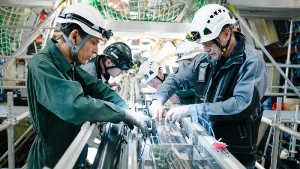Jun 9 2014
Last month, ATLAS, the particle detector that helped find the Higg’s boson, got an upgrade. Scientists at the Large Hadron Collider at CERN added a new set of sensors, called the Insertable b-Layer, or IBL, into the core of the detector.
The IBL will be closer to particle collisions than previous sensors and contain more, smaller pixels than any other sensors in ATLAS, adding precision to momentum and trajectory measurements of particles created during collisions.
 Installation of Insertable b-Layer, or IBL into the ATLAS detector of the Large Hadron Collider. Credit: Heinz Pernegger, CERN
Installation of Insertable b-Layer, or IBL into the ATLAS detector of the Large Hadron Collider. Credit: Heinz Pernegger, CERN
As the LHC accelerates particles to increasingly higher energies, the IBL will play an important role in detection of events. In particular, scientists hope to use it to better identify heavy particles such as bottom quarks, produced when short-lived particles like the Higgs boson decay, to further study the Higgs, and to search for new phenomena.
Physicist Karolos Potamianos, postdoctoral fellow at Lawrence Berkeley National Lab, was part of the team that prepared the IBL for operation within the ATLAS detector. Potamianos helped to test the device when it arrived at CERN and also to integrate the read-out of the IBL into the existing data-acquisition system.
The IBL, which will go online when the LHC runs again in March 2015, is “an important step toward future pixel detectors,” says Potamianos. He and physicist Maurice Garcia-Sciveres, postdoctoral physics fellow Laura Jeanty, and engineer Neal Hartman, all with Berkeley Lab, were part of the international team that contributed to the IBL development, construction, testing, and installation.
“We are looking forward to getting the IBL ready to provide us with valuable information,” Potamianos says. “With the LHC almost doubling its energy and the increased resolution of the IBL, we have the tools to shed light on known physics phenomena and hopefully discover something new to analyze along the way.”
You can read more about the IBL at Symmetry Magazine here. And watch a short video about the IBL installation, featuring Potamianos and Hartman, here.